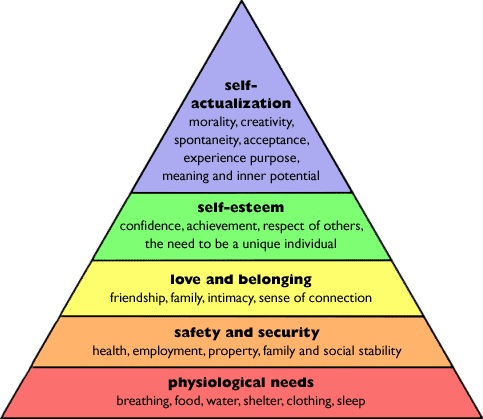Employee Happiness - Part 2
Our last blog post about making employees happy generated quite a few comments on LinkedIn discussion groups. One comment in particular focused on Maslow’s Hierarchy, which is a pyramid that moves from Physiological needs at the bottom, through Safety/Security, Love/Belonging, Esteem and Self-Actualization. The essence of the pyramid is that once we achieve each level, we pursue the next level and the pyramid implies a winnowing out as fewer people reach the higher levels of the hierarchy.
 We found the comment interesting because during the Great Recession and its aftermath many companies felt confident that employees would not leave on their own. Who would take a chance leaving a relatively secure job in the midst of the worst economic downturn since the Great Depression? Employees had achieved the lower rungs of the hierarchy (Physiological and Safety/Security) and were willing to hang on until the economic situation improved. Some recent studies seem to indicate the tide may be changing:
We found the comment interesting because during the Great Recession and its aftermath many companies felt confident that employees would not leave on their own. Who would take a chance leaving a relatively secure job in the midst of the worst economic downturn since the Great Depression? Employees had achieved the lower rungs of the hierarchy (Physiological and Safety/Security) and were willing to hang on until the economic situation improved. Some recent studies seem to indicate the tide may be changing:
A study by the National Bureau of Economic Research found that between 500,000 and 1 million people may leave their jobs because of the Affordable Healthcare Act (aka: Obamacare). Why? Many people stayed in jobs they hated or hesitated going into business for themselves because they needed or found safety in employer provided health insurance plans. Many of these workers have tremendous institutional knowledge they will take with them when they walk out the door (see Problem Solving and the Brain Drain).
A Gallup study, The 2013 State of the American Workplace Report, released in late June 2013, found that on 30% of American workers feel engaged or inspired at their jobs. The vast majority of workers, 70%, feel they are not achieving their full potential. Gallup estimates the cost of this disengagement at $450 to $550 billion per year for U.S. companies.
The Manufacturing Institute earlier this year reported that there were 600,000 open positions in the U.S. primarily because of a lack of skilled workers in the manufacturing sector. There is some debate on whether these are truly open positions because salaries have not risen to attract new employees. However, statistics show that the average age of those in skilled manufacturing positions is 56, meaning many of these employees will be retiring in the next few years, leaving a true skills gap if new generations of workers are not trained to take their place.
All this get us back to the question in our previous blog post: How do you make employees happy? If you believe Maslow’s Hierarchy, once employees meet their basic physical and safety needs, they want to feel that what they are doing has some meaning beyond a paycheck. Here are some of our thoughts on the upper levels of the pyramid, and how manufacturing companies can impact these areas:
Love/Belonging – This has to do with relationships. In a manufacturing environment, it can translate into being part of the team and having strong social relationships with peers, as well as those who manage them and who they manage. Companies that foster teamwork and develop employees’ team skills can help employees reach this level. Managers and supervisors who treat employees as people instead of just, well, employees can also help meet this need.
Esteem – This level focuses on confidence, having the respect of others and being seen as unique. Managers and supervisors have a large impact on this area by simple recognition for a job well done or a unique talent of an employee.
Self-actualization - In the workplace this can play out as creativity, acceptance and reaching full potential. This can be difficult, which is why so few people reach this level. Managers and supervisors need to work with each employee to fully understand what the employee considers as their potential and then push when needed to help get the employee there.
Smart managers and companies that are looking ahead can see a day in the not-so-distant future when they will need to do more than provide a paycheck and some job security to attract and retain the best and the brightest. Planning now using the ideas of Maslow's Heirarchy can help alleviate the worker shortage many experts predict.
